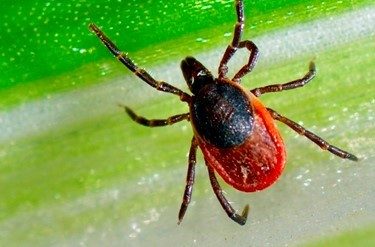Saskatchewan residents are being reminded to stay vigilant this fall when it comes to looking for ticks on themselves and pets.

According to the Ministry of Health, most ticks in the province are the American dog tick, which does not transmit Lyme disease to people. They are most active from mid-April to the end of July.
However, black-legged ticks, remain active throughout the fall, particularly in tall grass, brush or wooded areas. Although rare, these ticks can cause Lyme disease.
So far this year, 3,022 ticks were submitted to the ministry between April and July. Of that, only 11 were black-legged ticks and of the six tested to date, three were positive for the bacterium that causes Lyme disease.
On April 1, the government, in collaboration with the University of Saskatchewan, launched eTick, an image-based tick identification platform.
Users can submit photographs of ticks they find either on themselves, pets or livestock, in order to receive information about the type of tick and your risk of exposure to tick-borne diseases.

Get daily National news
“Data received through the eTick platform will allow us to monitor the distribution and level of establishment of ticks, specifically black-legged tick populations, and assist in monitoring the risk of Lyme disease across the province,” consulting medical health officer Dr. Denise Werker said in a press release.
- Retired Quebec teacher buys winning lottery ticket at last minute, wins $40M
- N.B. election: Higgs went to ‘very dark place’ with Liberal joke, opponent says
- NDP want competition watchdog to probe potential rent-fixing by landlords
- Jasper mayor says CN Rail relocation will be devastating: ‘Deeply disappointed’
“While the risk of Lyme disease is low in Saskatchewan, it is still important for people to take precautions against ticks.”
These precautions include wearing pants, long-sleeved shirts and shoes that don’t expose your feet, pulling socks up over your pant legs and wearing light-coloured clothes so ticks can be easily spotted.
Other recommendations include dong a full body check on yourself, children or pets after being outside, shower or bathe after being outside and wear clothing that has been treated with the insecticide permethrin, approved for those over the age of 16.
If you do find a tick attached to your skin or pet, these are the following recommendations:
- Carefully remove it with fine-tipped tweezers and grasp the mouth parts of the tick as close to the skin as possible.
- Pull slowly upward and out with a firm, steady pressure.
- Be careful not to squeeze, crush or puncture the body after removal as this may also contain infectious fluids.
- Do not put Vaseline, gasoline, or other noxious substances on an attached tick which may cause it to regurgitate.
- Submit photos of your tick using the eTick system and hang onto your tick in case it is needed for further testing. Ticks can be euthanized by placing it in a bag and storing it in the freezer for 24 hours.
- In Saskatchewan, any ticks found in the fall are likely to be ticks of interest, such as the black-legged tick.









Comments